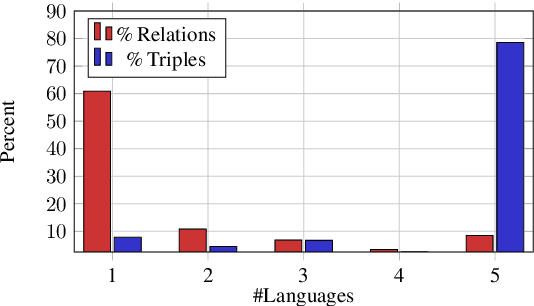Harkanwar Singh
PopAlign: Population-Level Alignment for Fair Text-to-Image Generation
Jun 28, 2024Abstract:Text-to-image (T2I) models achieve high-fidelity generation through extensive training on large datasets. However, these models may unintentionally pick up undesirable biases of their training data, such as over-representation of particular identities in gender or ethnicity neutral prompts. Existing alignment methods such as Reinforcement Learning from Human Feedback (RLHF) and Direct Preference Optimization (DPO) fail to address this problem effectively because they operate on pairwise preferences consisting of individual samples, while the aforementioned biases can only be measured at a population level. For example, a single sample for the prompt "doctor" could be male or female, but a model generating predominantly male doctors even with repeated sampling reflects a gender bias. To address this limitation, we introduce PopAlign, a novel approach for population-level preference optimization, while standard optimization would prefer entire sets of samples over others. We further derive a stochastic lower bound that directly optimizes for individual samples from preferred populations over others for scalable training. Using human evaluation and standard image quality and bias metrics, we show that PopAlign significantly mitigates the bias of pretrained T2I models while largely preserving the generation quality. Code is available at https://github.com/jacklishufan/PopAlignSDXL.
Mamba-ND: Selective State Space Modeling for Multi-Dimensional Data
Feb 08, 2024



Abstract:In recent years, Transformers have become the de-facto architecture for sequence modeling on text and a variety of multi-dimensional data, such as images and video. However, the use of self-attention layers in a Transformer incurs prohibitive compute and memory complexity that scales quadratically w.r.t. the sequence length. A recent architecture, Mamba, based on state space models has been shown to achieve comparable performance for modeling text sequences, while scaling linearly with the sequence length. In this work, we present Mamba-ND, a generalized design extending the Mamba architecture to arbitrary multi-dimensional data. Our design alternatively unravels the input data across different dimensions following row-major orderings. We provide a systematic comparison of Mamba-ND with several other alternatives, based on prior multi-dimensional extensions such as Bi-directional LSTMs and S4ND. Empirically, we show that Mamba-ND demonstrates performance competitive with the state-of-the-art on a variety of multi-dimensional benchmarks, including ImageNet-1K classification, HMDB-51 action recognition, and ERA5 weather forecasting.
InstructAny2Pix: Flexible Visual Editing via Multimodal Instruction Following
Dec 30, 2023



Abstract:The ability to provide fine-grained control for generating and editing visual imagery has profound implications for computer vision and its applications. Previous works have explored extending controllability in two directions: instruction tuning with text-based prompts and multi-modal conditioning. However, these works make one or more unnatural assumptions on the number and/or type of modality inputs used to express controllability. We propose InstructAny2Pix, a flexible multi-modal instruction-following system that enables users to edit an input image using instructions involving audio, images, and text. InstructAny2Pix consists of three building blocks that facilitate this capability: a multi-modal encoder that encodes different modalities such as images and audio into a unified latent space, a diffusion model that learns to decode representations in this latent space into images, and a multi-modal LLM that can understand instructions involving multiple images and audio pieces and generate a conditional embedding of the desired output, which can be used by the diffusion decoder. Additionally, to facilitate training efficiency and improve generation quality, we include an additional refinement prior module that enhances the visual quality of LLM outputs. These designs are critical to the performance of our system. We demonstrate that our system can perform a series of novel instruction-guided editing tasks. The code is available at https://github.com/jacklishufan/InstructAny2Pix.git
Multilingual Knowledge Graph Completion with Joint Relation and Entity Alignment
Apr 18, 2021



Abstract:Knowledge Graph Completion (KGC) predicts missing facts in an incomplete Knowledge Graph. Almost all of existing KGC research is applicable to only one KG at a time, and in one language only. However, different language speakers may maintain separate KGs in their language and no individual KG is expected to be complete. Moreover, common entities or relations in these KGs have different surface forms and IDs, leading to ID proliferation. Entity alignment (EA) and relation alignment (RA) tasks resolve this by recognizing pairs of entity (relation) IDs in different KGs that represent the same entity (relation). This can further help prediction of missing facts, since knowledge from one KG is likely to benefit completion of another. High confidence predictions may also add valuable information for the alignment tasks. In response, we study the novel task of jointly training multilingual KGC, relation alignment and entity alignment models. We present ALIGNKGC, which uses some seed alignments to jointly optimize all three of KGC, EA and RA losses. A key component of ALIGNKGC is an embedding based soft notion of asymmetric overlap defined on the (subject, object) set signatures of relations this aids in better predicting relations that are equivalent to or implied by other relations. Extensive experiments with DBPedia in five languages establish the benefits of joint training for all tasks, achieving 10-32 MRR improvements of ALIGNKGC over a strong state-of-the-art single-KGC system completion model over each monolingual KG . Further, ALIGNKGC achieves reasonable gains in EA and RA tasks over a vanilla completion model over a KG that combines all facts without alignment, underscoring the value of joint training for these tasks.
 Add to Chrome
Add to Chrome Add to Firefox
Add to Firefox Add to Edge
Add to Edge